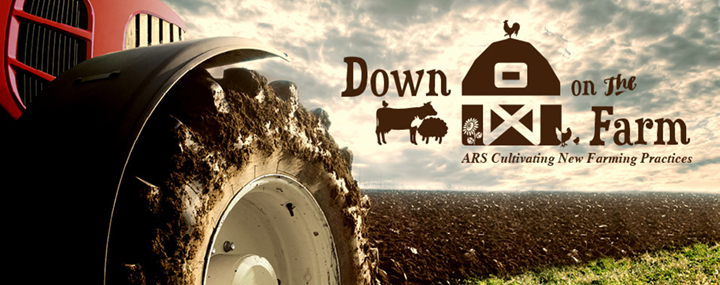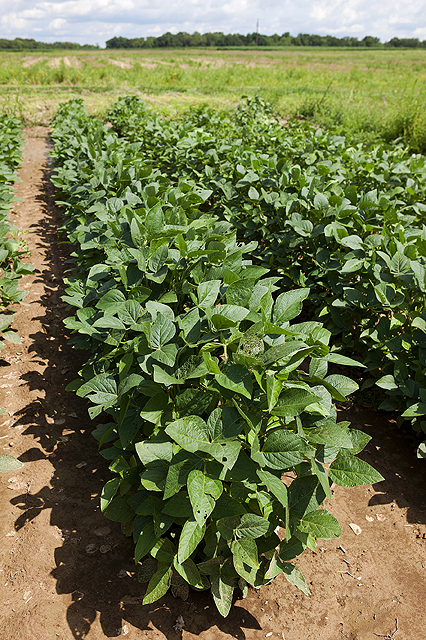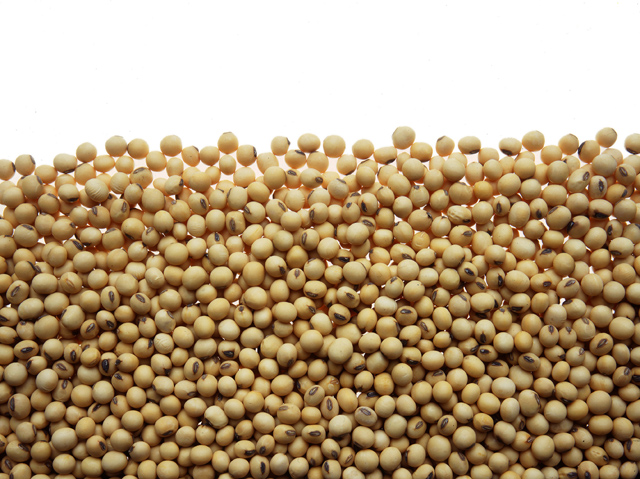
Building a Better Bean
How ARS Scientists are Making Soybeans Healthier and More Digestible
Soybeans are everywhere in our food supply, from nuts, meat substitutes and tofu to soymilk. This popular crop, grown across the Midwest, is also widely used as a feed for livestock. The health benefits of soybeans are crucial to both animal and human health: Soybeans are high in fiber and protein, and low in saturated fat. Unfortunately, some of the sugar compounds that make up the carbohydrates in soybeans can be difficult to digest – whether on the dinner plate or in the feed bowl.
Research evidence shows reducing the levels of the undesirable sugars, raffinose and stachyose, which are difficult for animals to digest, resulted in increased levels of sucrose, a highly digestible sugar, which potentially results in improvement of the energy content and overall digestibility of the soybean meal.
"Raffinose and stachyose carbohydrates cause a sort of gastric distress and slow growth," said Karen Hudson, research molecular biologist at ARS's Crop Production and Pest Control Research Unit in West Lafayette, IN. "It makes the animals more susceptible to getting sick while they're growing. So, by eliminating those compounds, farmers are able to raise healthier animals that grow faster."
 Soybean plants. (Peggy Greb, D2528-1)
Soybean plants. (Peggy Greb, D2528-1)
Hudson and her colleague, Kristin Bilyeu, are leading research into redesigning the energy source of soybeans in order to improve the usefulness of soy protein to animals. They are trying to understand how to make soybean meal easier for animals to digest. Bilyeu, who is also a research molecular biologist, conducts plant genetics research in Columbia, MO. The two have been working together on modifying the composition of soybeans for 10 years, and have discovered that reconstructing the carbohydrate makeup of the protein in the seed is important for animals as well as for human plant-based diets. Their research is currently focused on reducing some types of sugar compounds and increasing others in soybean seeds to make soy protein more digestible and healthier for animals.
Part of their work involves looking at the similarities and differences in growth rate among animals. Other collaborators involved include Dr. Katy Martin Rainey at Purdue University. She led a United Soybean Board-funded project on soybean carbohydrate for many years that both Hudson and Bilyeu have worked on. This research affects animal feeds and in turn affects the food humans consume. They are also using various methods to understand the development of soybean seeds and how the protein is partitioned.
"[We are] looking at the total levels of protein in soybeans," Hudson said. "We're really trying to understand how the soybean seed develops and partitions its resources into protein, oil, and carbohydrates and what genetic factors control that."
 Soybeans. (Peggy Greb, K9006-1)
Soybeans. (Peggy Greb, K9006-1)
On the human nutrition side, Hudson and Bilyeu are collaborating with food scientists to use soybean seeds with the desirable modified carbohydrate profiles to learn how to process soy protein, which can be used in human food and can play a role in plant-based diets.
Bilyeu's research has produced new knowledge about seed composition, plant maturity, and adaptation.
"This knowledge has been translated into new soybean varieties that are more profitable for the farmers and meet end user demands for higher product quality, functionality, and value," she said. "It is my goal to have my research endeavors have a positive impact all the way to the dinner plate." — By Fiona Hernandez, ARS Office of Communications
